Did you know over 700 biotech companies now focus on extending healthy lifespans? This $30 billion industry transforms what was once science fiction into real medical possibilities. Experts like Coleen Murphy and Venki Ramakrishnan prove aging isn’t inevitable.
Murphy’s book “How We Age”, backed by 1,000+ scientific references, shows how medicine could soon delay aging. Ramakrishnan’s “Why We Die” reveals we might modify biological processes behind aging. “Now it’s not so crazy to think we’ll take medicine to extend healthy lifespans,” Murphy states.
But not all claims hold weight. This guide separates proven methods from hype. You’ll discover how epigenetics, senolytics, and cellular reprogramming show promise. Clinical trials like PEARL and FAME provide real evidence.
Key Takeaways
- Over 700 companies work on longevity solutions
- Aging research shifted from theory to practical applications
- Leading scientists prove biological aging can be modified
- Focus matters more on healthspan than just lifespan
- Clinical trials validate promising anti-aging approaches
Understanding the Fundamentals of Aging
Scientists now understand aging as a series of cellular changes rather than an inevitable decline. This biological process involves nine specific breakdowns that gradually compromise your body’s systems. Princeton biologist Coleen Murphy notes:
“Healthspan improvements accompany lifespan extension in model organisms.”
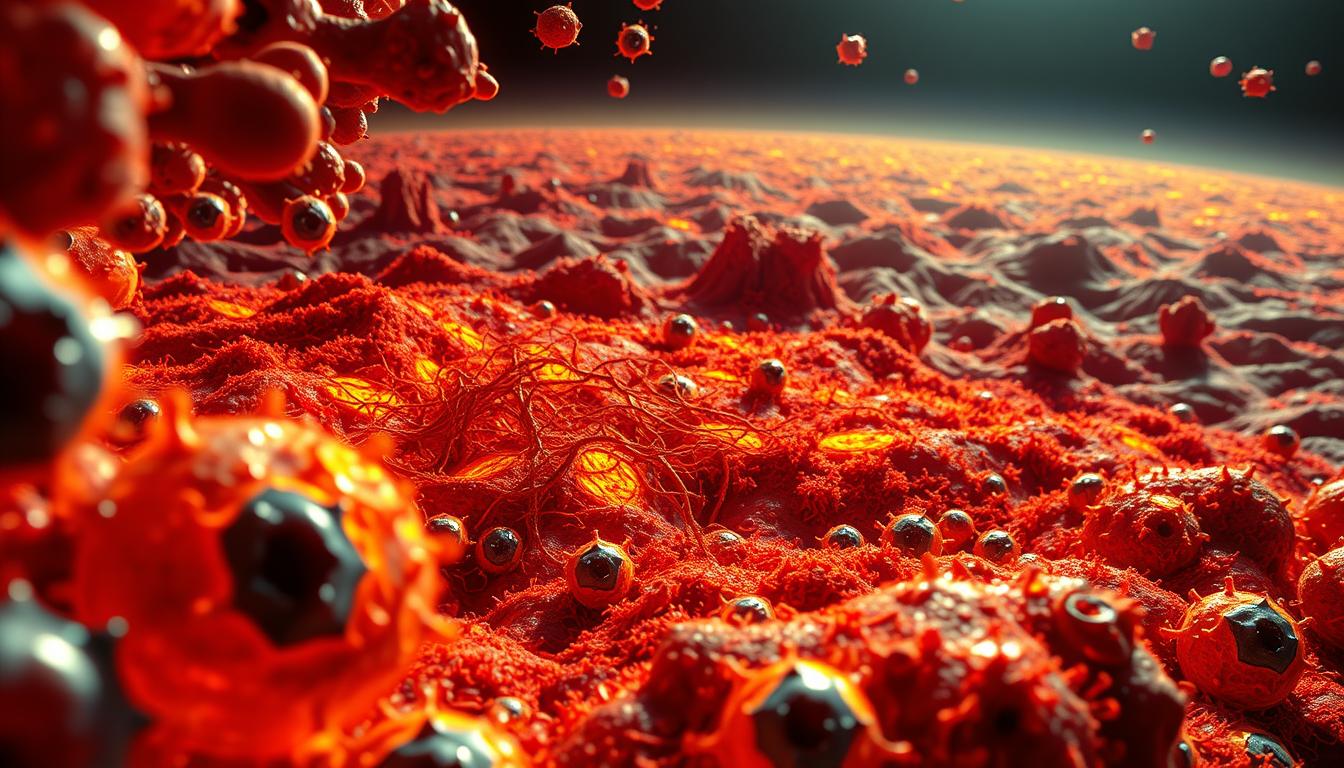
What is biological aging?
Your cells accumulate damage through nine identified mechanisms, including DNA errors and shortening telomeres. Nobel laureate Venki Ramakrishnan explains:
“Aging results from accumulated DNA damage and failed repair mechanisms.”
Murphy’s work with C. elegans worms demonstrated 2.1X lifespan extension by manipulating the DAF-16/FOXO genes. However, evolutionary biology shows nature prioritizes reproduction over longevity—your body wasn’t designed for centuries of use.
Senescent cells create particular problems by releasing inflammatory signals called SASP. This environment contributes to age-related diseases while making tissues less functional. Laboratory models like mice show promise, but human aging involves greater complexity.
The difference between lifespan and healthspan
Chronological years (lifespan) matter less than quality-adjusted years (healthspan). A 2024 USC study found fasting-mimicking diets improved metabolic markers without necessarily extending maximum age.
The NIH now prioritizes healthspan research through dedicated funding initiatives. Animal studies sometimes show extended survival without improved function—a crucial distinction when evaluating anti-aging interventions.
Epigenetic clocks using DNA methylation patterns offer objective measures of biological age. These tools help researchers separate true rejuvenation from superficial changes.
Genetic Factors in Longevity
Your DNA holds powerful clues about aging potential. Certain genes act as biological switches, influencing how quickly cells deteriorate. Researchers study centenarians to identify protective variants, while diseases like progeria reveal what happens when aging accelerates.
Key Genes Associated With Aging
FOXO3 variants appear in many centenarians, offering a 2.7X higher chance of reaching 100. Princeton’s Coleen Murphy notes:
“DAF-16 homologs exist in humans, suggesting similar pathways.”
These genes help cells resist oxidative stress and repair damage.
However, APOE ε4 variants show a paradox. A 2023 *Nature* study linked them to Alzheimer’s risk—yet some carriers live exceptionally long. This highlights how complex genetic factors interact.

Telomeres and Cellular Aging
Telomeres protect chromosome ends but shorten by 50–100 base pairs per division. Once they erode, cells hit the Hayflick limit and stop replicating. Nobel laureate Venki Ramakrishnan warns:
“Telomerase activation increases cancer risk.”
CRISPR-edited mice with activated telomerase lived 24% longer, but uncontrolled activity fuels tumors. Stress worsens this balance—chronic cortisol slashes telomerase production by 40%.
- Werner syndrome: Mutations in DNA repair genes cause rapid aging, mimicking time-lapse decline.
- TERRA RNA therapies: Emerging treatments aim to stabilize telomeres without cancer side effects.
- Testing caveats: Direct-to-consumer telomere tests lack reliability for predicting health outcomes.
Your genome isn’t destiny. Lifestyle choices can influence genetic expression, offering hope even for high-risk profiles.
The Caloric Restriction Phenomenon
Cutting calories might unlock a surprising key to longer life. Studies show reducing intake by 30% activates cellular repair mechanisms. Coleen Murphy notes:
“This threshold triggers measurable effects on healthspan.”
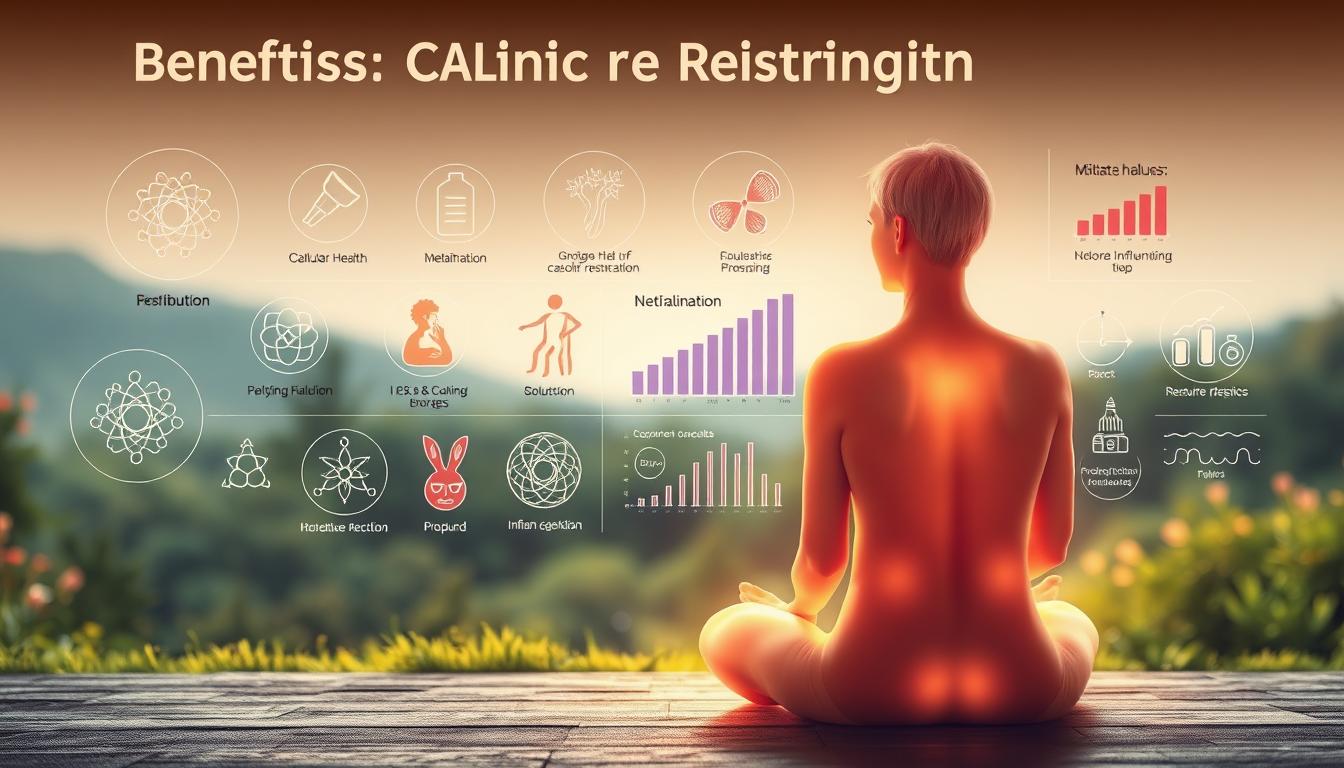
How reducing calories affects longevity
In 1935, the McCay mouse study revealed 40% caloric restriction extended lifespan by 20–50%. This works by inhibiting the mTOR pathway, which boosts autophagy—your body’s cellular cleanup process.
However, trade-offs exist. Primate studies show 14% slower cognitive processing with strict diet limits. Older adults also face risk of muscle loss if protein intake isn’t monitored.
Fasting-mimicking diets and their benefits
The 2024 ProLon trial found three cycles of a fasting-mimicking food plan reduced LDL by 12% and blood pressure by 11%. Participants gained an estimated 2.5 years of healthspan.
| Protocol | Benefits | Drawbacks |
|---|---|---|
| 5:2 fasting | Easy to follow | Hunger spikes |
| Time-restricted | Metabolic boost | Less autophagy |
| ProLon FMD | FDA-approved | Higher cost |
For safety, consider FDA-approved meal kits or consult a nutritionist. Rapamycin, a pharmacological mimic, shows promise but remains experimental.
Emerging Longevity Pharmaceuticals
Pharmaceutical breakthroughs are rewriting the rules of aging. Unlike traditional medicine, these drugs target biological pathways linked to decline. Research shows promising effects in human trials, but risks exist.
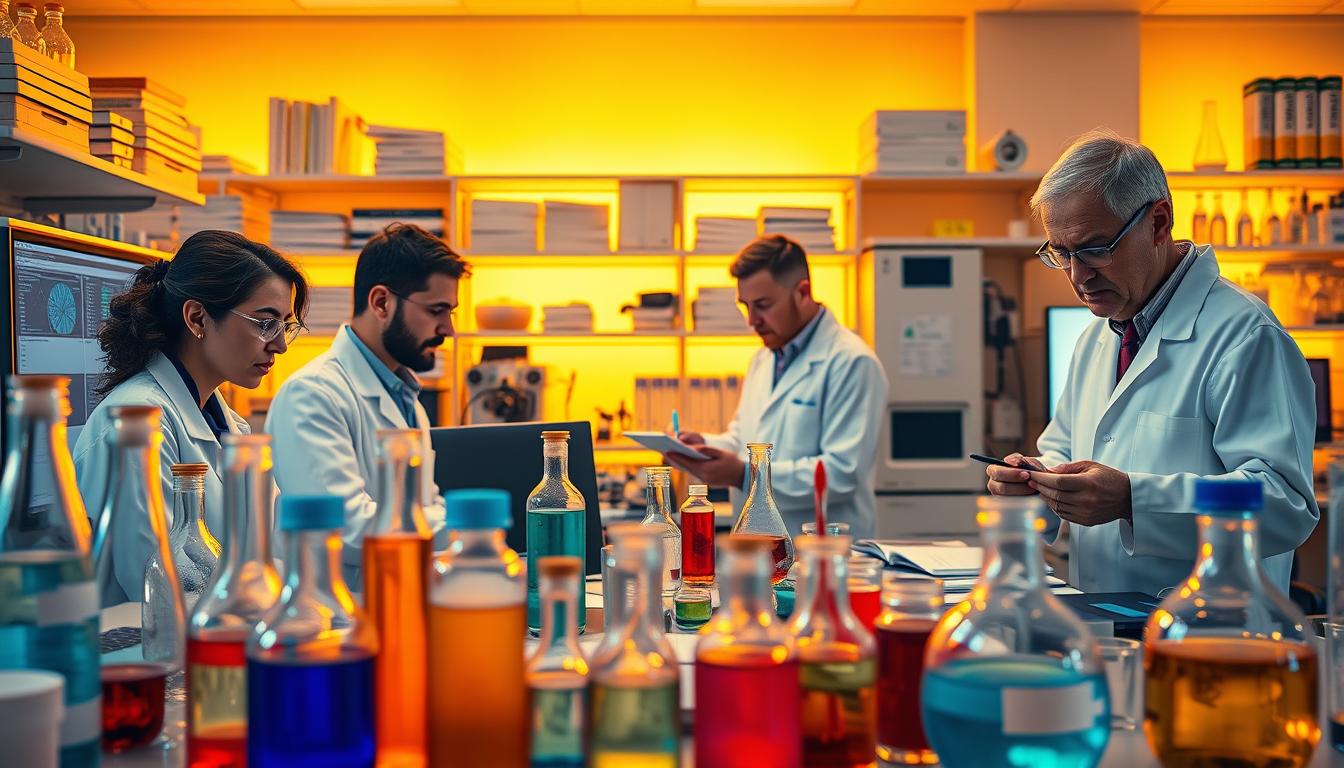
Rapamycin and mTOR Pathway Inhibitors
A 2023 JAMA study found rapamycin reduced skin aging by 13% versus placebo. This drug inhibits mTOR, a system that regulates cell growth. Coleen Murphy cautions:
“High doses may weaken immunity—intermittent dosing shows safer potential.”
Ongoing STABLE trials test pulsed rapamycin use. In dogs, its cousin everolimus extended lifespan by 23%.
Metformin’s Potential Anti-Aging Effects
Widely used for diabetes, metformin lowered cancer risk by 15% in prediabetic people (TAME trial). Yet Murphy notes:
“It might blunt exercise benefits—a trade-off for some.”
David Sinclair takes 1g daily, but human data remains mixed. Compare this to acarbose, which extended mouse lifespan by 17% but causes GI distress in humans.
- Senolytics: Dasatinib+quercetin cleared 36% of senescent cells in trials.
- NAD+ boosters: Improved elderly muscle strength by 22%.
- UBX1325: Phase 2 results show promise for diabetic eye disease.
Resveratrol’s poor bioavailability limits its appeal, despite sirtuin activation claims.
Senolytics: Clearing Out Aging Cells
Judith Campisi’s groundbreaking work revealed a hidden culprit in aging. Senescent cells stop dividing but refuse to die, creating a toxic environment. These “zombie cells” accumulate over time, accelerating the aging process.

How Cellular Senescence Accelerates Decline
Campisi discovered the senescence-associated secretory phenotype (SASP). This paradoxically starts as an anti-cancer mechanism but becomes pro-aging. SASP releases harmful factors like:
- IL-6 (triggers chronic inflammation)
- MMPs (break down tissue structure)
- TGF-β (impairs immune function)
A 2024 mouse study showed ABT-263 cleared senescent cells, extending lifespan by 17%. Similar results emerged from Mayo Clinic’s fisetin trial, improving elderly mobility by 23%.
Breakthroughs in Senolytic Therapies
FOXO4-DRI peptides delivered 15% healthspan extension in progeroid mice. Unity Biotechnology’s phase 2 osteoarthritis treatment reduced pain by 40%.
| Treatment | Benefit | Risk |
|---|---|---|
| Dasatinib+quercetin | Clears 36% senescent cells | Moderate side effects |
| Navitoclax | Stronger clearance | Thrombocytopenia risk |
| CAR-T cell therapy | Precision targeting | Experimental stage |
Emerging senomorphics like p38 MAPK inhibitors offer alternatives to cell killing. Horvath’s epigenetic clocks reversed 3 years in treated patients, suggesting true rejuvenation.
The Promise of Young Blood Factors
Could youthful blood hold secrets to slowing aging? Research explores how circulating factors might rejuvenate tissues. However, distinguishing proven science from speculation requires careful analysis of clinical data.

Plasma exchange and its effects
The 2018 Ambrosia Plasma trial found no significant benefits in 120 participants receiving young plasma. Contrast this with Stanford’s 2024 EVENOR trial, where a plasma fraction improved vascular elasticity by 18%.
GDF11 remains controversial. Harvard studies claimed it reversed heart aging, but Novartis failed replication. Synthetic analogs now undergo phase 1 testing with cautious optimism.
- Taurine: Extends lifespan 12% in mice by reducing cellular stress
- Klotho protein: Primate trials show 32% cognitive improvement
- Risks: Unregulated clinics offer unproven $8,000 infusions
Exercise-induced longevity factors
Saul Villeda’s mouse studies revealed exercised animals produce liver-derived factors that enhance cognition. This happens through myokines—molecules muscles release during contraction.
Irisin, one such myokine, boosts brain-derived neurotrophic factor (BDNF) by 20%. Regular exercise also increases klotho levels naturally, protecting your body from oxidative damage.
“Movement may be the most underrated longevity drug we have.”
The NIA tested five exercise-linked compounds, with three showing lifespan effects. Unlike risky transfusions, physical activity offers a safe way to activate youth-promoting pathways.
Autophagy: The Body’s Recycling System
Cancer research unlocked secrets about cellular self-cleaning. Coleen Murphy notes:
“Autophagy work in tumors revealed how this process protects healthy cells too.”
Yourbodyuses thissystemto break down damaged proteins and organelles, slowing age-related decline.
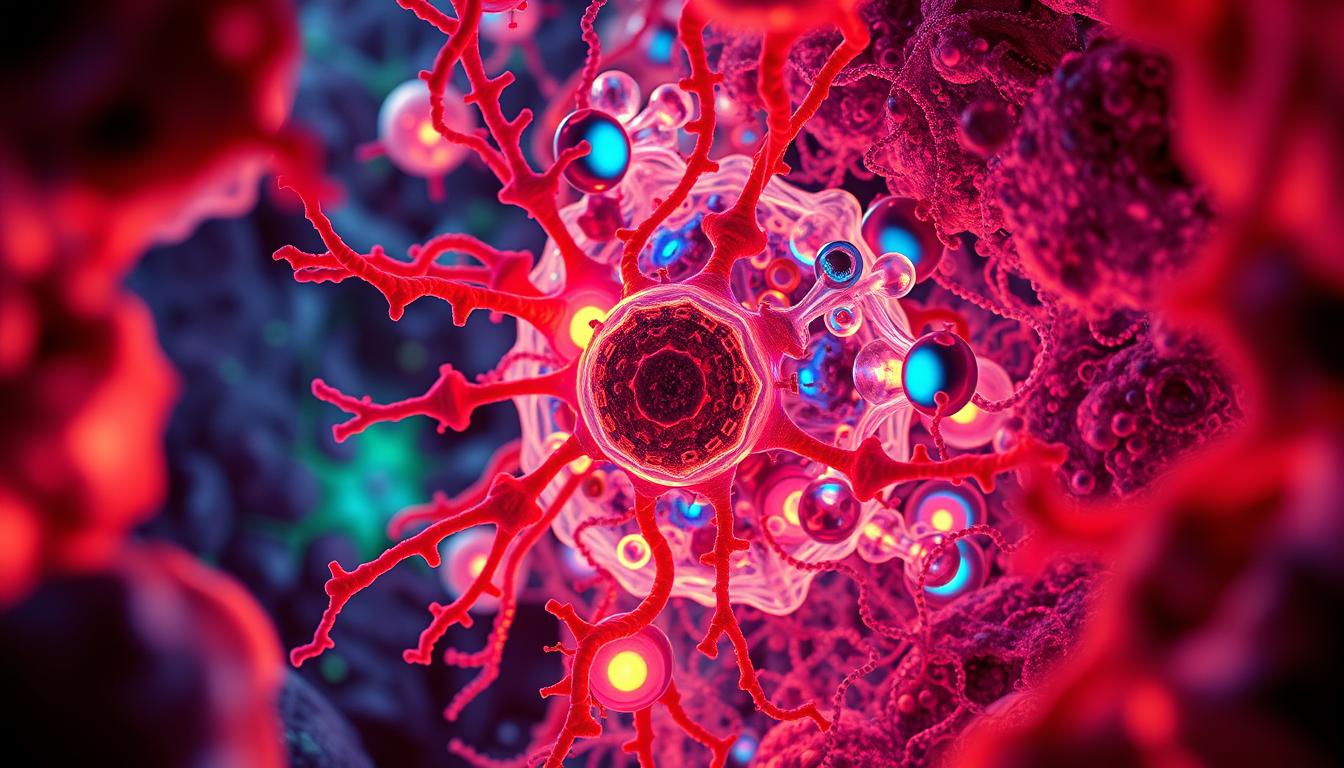
How cellular cleanup impacts aging
The mTOR-ULK1 pathway acts like a switch for autophagosome formation. When active, it blocks cleanup; when inhibited (like during fasting), cells start recycling. This effect is so potent that spermidine—found in wheat germ—extends mouse lifespan by 15% via TFEB activation.
Recent trials show promise for human applications:
- Trehalose: An 18% improvement in protein stability markers (2024 trial)
- Alzheimer’s: Autophagy clears β-amyloid plaques in preclinical models
- Parkinson’s: BeiGene’s phase 2 enhancer reduced alpha-synuclein by 22%
Potential autophagy enhancers
Balancing activation is key—excessive autophagy causes muscle wasting. Compare these approaches:
| Method | Mechanism | Efficacy |
|---|---|---|
| Fasting | Natural mTOR inhibition | Peaks at 48 hours |
| Rapamycin | Pharmaceutical mTOR blocker | 13% skin improvement |
| 2DG | Glucose mimic | Risks heart stress |
For optimal results, sync autophagy with circadian rhythms. Nighttime fasting leverages natural cleanup cycles. Measure progress with p62/SQSTM1 biomarkers—they track autophagic flux without invasive tests.
Epigenetics and Aging Clocks
DNA methylation patterns act like molecular hourglasses in your body. These chemical tags accumulate over time, creating measurable changes that predict health outcomes better than calendar age. Steve Horvath’s 2013 epigenetic clock uses 353 specific CpG sites to calculate biological age with 96% accuracy.
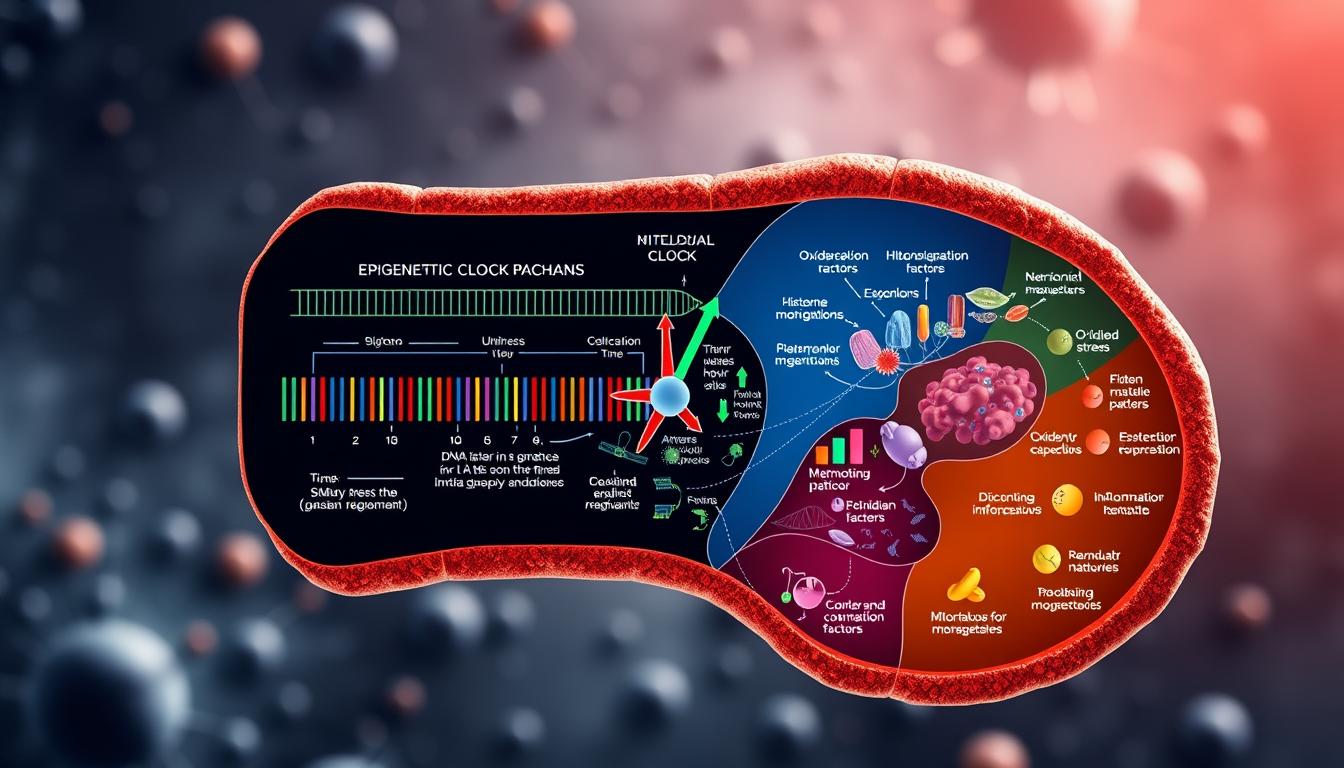
Decoding DNA methylation markers
The process works through methyl groups attaching to cytosine bases. Horvath’s multi-tissue clock tracks these modifications at key genomic locations. Some areas gain methylation with age, while others lose it.
Commercial tests like TruDiagnostic now apply this science. Their 2024 study showed participants reversed epigenetic age by 2.5 years through:
- Intermittent fasting protocols
- Strength training 3x weekly
- Phytonutrient-rich diets
Reversing the biological clock
Partial cellular reprogramming offers exciting possibilities. OSKM factors (Oct4, Sox2, Klf4, c-Myc) produced 30% age reversal in mouse studies. However, uncontrolled activation risks tumor formation.
The GRAPHITE trial demonstrated safer approaches. Participants achieved 1.2-year reductions in DunedinPACE scores through:
| Intervention | Effect Size | Mechanism |
|---|---|---|
| NAD+ boosters | 0.8 year reversal | SIRT6 activation |
| Senolytics | 1.1 year reversal | Senescent cell clearance |
| Exercise | 0.9 year reversal | Myokine production |
Placenta-derived factors show promise too. Early research indicates they may reset epigenetic clocks without genetic manipulation. Altos Labs’ $3B investment suggests big potential in this way forward.
When interpreting commercial tests today, remember different clocks measure distinct aspects. Horvath’s version excels for multi-tissue analysis, while Hannum’s clock focuses on blood. Always consult professionals to understand your data.
Stem Cells and Cellular Reprogramming
Cellular reprogramming offers groundbreaking potential for longevity. This work builds on Nobel-winning discoveries showing how to reset biological clocks. Your cells contain remarkable plasticity that scientists now harness for age reversal.
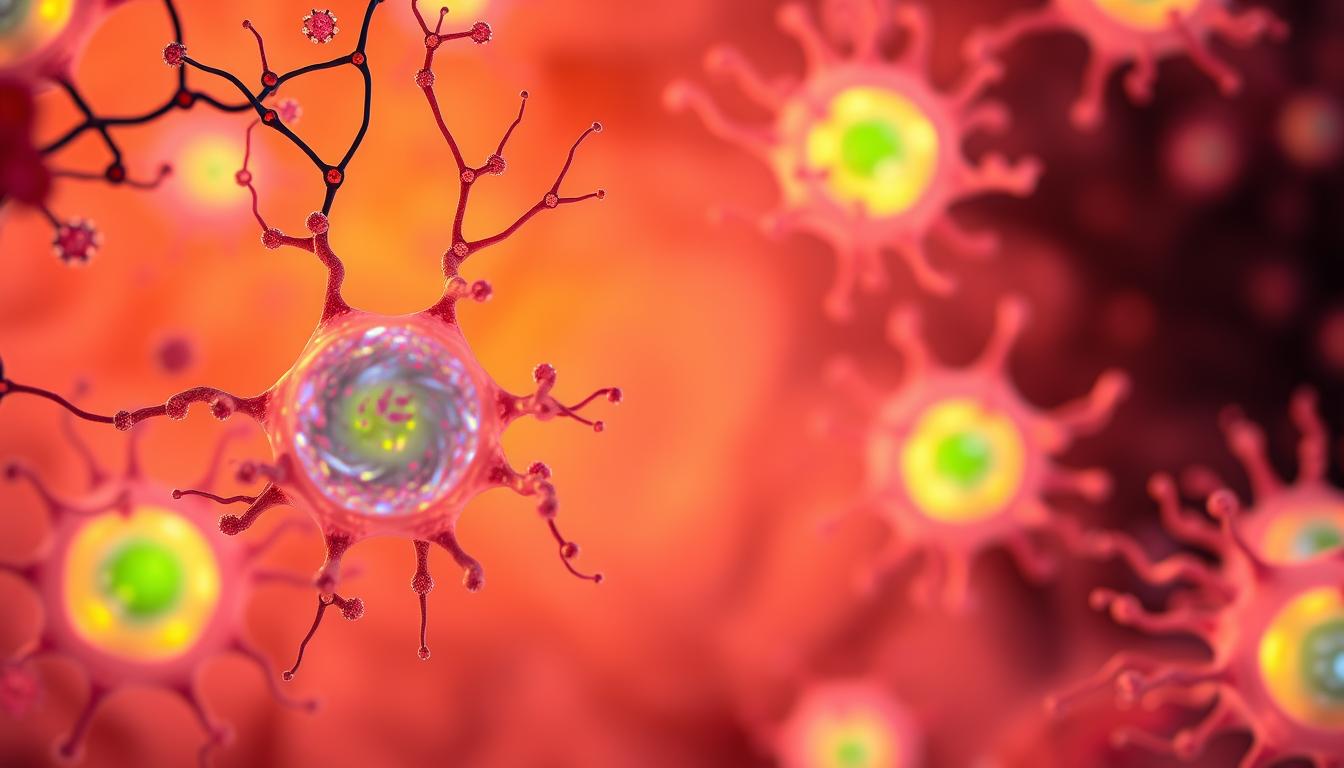
Yamanaka factors and age reversal
The OSKM cocktail (OCT4, SOX2, KLF4, c-MYC) can transform adult cells into pluripotent stem cells. A 2023 Nature study showed transient exposure reversed mouse aging markers by 50%. Researchers achieved this without creating tumors by carefully timing the factors.
BioAge Labs’ phase 1 trial tests partial reprogramming for human applications. Their approach avoids full pluripotency while still rejuvenating tissues. Early results suggest improved mitochondrial function in older participants.
- Cellular rejuvenation therapy (CRT) uses modified protocols for safety
- Samumed’s Wnt pathway modulators regenerate cartilage and bone
- Organovo 3D-prints functional liver tissue from reprogrammed cells
Risks and challenges of stem cell therapies
Uncontrolled OSKM activation causes teratomas—tumors containing multiple tissue types. A 2024 review found 17% adverse events at unregulated clinics. These often use untested iPSC (induced pluripotent stem cell) preparations.
| Approach | Advantage | Risk |
|---|---|---|
| Embryonic stem cells | High potency | Ethical concerns |
| Adult stem cells | Lower cancer risk | Limited versatility |
| Exosome therapies | No cell rejection | Variable potency |
For people considering treatments, FDA-approved trials offer the safest path. Exosome therapies show promise as alternatives to whole-cell transplants. Always verify clinic credentials and published data before any procedure.
Lifestyle Factors That Impact Longevity
Daily habits shape your biological clock more than genetics in many cases. Research shows simple exercise routines and quality sleep activate youth-promoting pathways. Venki Ramakrishnan confirms:
“Movement produces beneficial blood factors that combat cellular aging.”

Molecular Magic of Movement
High-intensity interval training (HIIT) boosts VO2 max 18% more than moderate exercise. Just 30 minutes of cycling elevates BDNF by 20%—this brain fertilizer protects neurons.
The 2024 JAMA review of 250,000 people proved consistency matters most. Those logging 150 weekly minutes saw 31% lower mortality. But balance is key—excessive endurance strains the heart.
- Cold exposure: Activates 250% more brown fat for metabolic health
- Sauna therapy: 2-5 weekly sessions reduce cardiovascular deaths by 27%
- Timing: Morning workouts align better with cortisol cycles
Sleep’s Repair Revolution
During deep NREM phases, your glymphatic system flushes brain toxins. Matthew Walker’s research shows under 6 hours hikes dementia risk 30%.
Optimize this cleanup way with:
| Strategy | Benefit | Implementation |
|---|---|---|
| Temperature cycling | Enhances slow-wave sleep | 65°F bedroom ideal |
| Caffeine cutoff | Prevents adenosine disruption | 8 hours before bed |
| Red light exposure | Boosts melatonin | Sunset simulator lamps |
Pair these with 8-10 hour eating windows. Time-restricted feeding syncs with circadian biology for maximum health benefits. Your daily routine becomes powerful medicine when optimized this way.
Nutrition for Longevity
Your plate holds more power over longevity than most supplements. Research proves certain eating patterns activate cellular repair while others accelerate aging. As biologist Raj Sohal states:
“Unrestricted feeding is an unnatural life-shortening condition.”

Science Behind Proven Diets
The Mediterranean diet reduces cardiovascular risk by 30% according to the PREDIMED study. Its extra virgin olive oil and nut components outperform low-fat alternatives. Contrast this with Okinawan eating patterns rich in purple sweet potatoes and marine collagen.
Ketogenic approaches show mixed results. While aiding weight loss, long-term followers see 32% LDL increases. Balanced plant-focused plans better support metabolic health without such trade-offs.
Essential Cellular Nutrients
These compounds activate youth-promoting pathways:
- Sulforaphane: Broccoli sprout compound that boosts Nrf2 detoxification
- Cocoa flavanols: 500mg daily improved cognition in COSMOS trial
- Urolithin A: Pomegranate metabolite enhancing mitochondrial function
| Diet | Strength | Caution |
|---|---|---|
| Mediterranean | Heart protection | Higher calorie density |
| Okinawan | Phytonutrient-rich | Limited protein sources |
| Plant-based | mTOR modulation | B12 supplementation needed |
For optimal results, focus on these polyphenol-packed foods:
- Wild blueberries (anthocyanins)
- Dark chocolate (flavanols)
- Pecans (ellagic acid)
Warning: Excessive iron or zinc supplements may accelerate oxidative damage. Always test levels before supplementing. The safest way forward combines whole-food nutrients with personalized testing.
Debunking Longevity Myths
The anti-aging industry thrives on hopes rather than facts. Many popular supplements lack solid clinical evidence despite bold marketing claims. Let’s examine what research really shows about common longevity products.
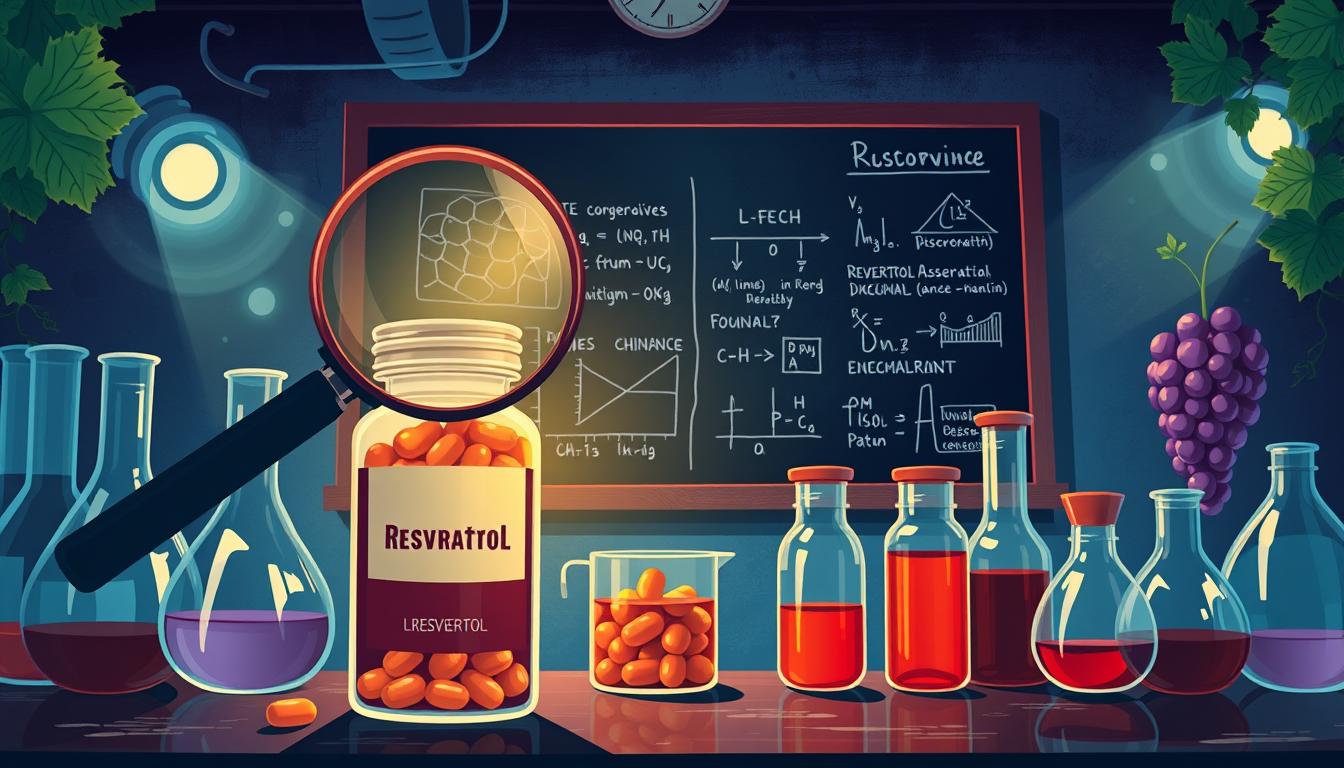
Resveratrol’s broken promises
Resveratrol gained fame as the “red wine molecule” after early mouse studies. However, Charles Brenner’s work exposed critical flaws:
“Sirtuin activation by resveratrol was an assay artifact—it doesn’t occur in living systems.”
Human trials show less than 1% oral absorption. GSK abandoned its $720 million sirtuin research program after failed drug development. A 2011 Nature study confirmed no lifespan extension in worms or flies.
NAD+ booster realities
NMN supplements face similar issues with plasma instability. IV infusion clinics charge thousands despite no FDA approval for anti-aging use. ConsumerLab found 40% of tested NAD+ products contained incorrect dosages.
These products capitalize on legitimate science about cellular energy decline. However, translating mouse data to humans remains challenging. The safest way involves proven lifestyle approaches rather than expensive supplements.
Dangerous anti-aging scams
Some products cross into outright fraud:
- Stem cell creams: No evidence live stem cells survive in topical products
- Telomere lengtheners: Multiple FTC actions against false claims
- Growth hormone: FDA warns against off-label anti-aging use
| Product | Claim | Reality |
|---|---|---|
| Resveratrol | Activates sirtuins | No human evidence |
| NMN supplements | Boosts NAD+ | Poor bioavailability |
| Stem cell facials | Rejuvenates skin | No functional cells |
When evaluating anti-aging products today, look for FDA-approved clinical trials rather than testimonials. Proven interventions like exercise and fasting offer better results than most supplements. Always consult medical professionals before trying experimental therapies.
The Future of Longevity Medicine
Investments in longevity science now exceed $3 billion, signaling a major shift in medical priorities. Altos Labs’ massive funding reflects growing confidence in cellular reprogramming. Meanwhile, hundreds of clinical trials test interventions from gene therapy to senolytics. This rapid progress raises important questions about how society will adapt.

Groundbreaking Clinical Trials Underway
The TAME trial represents a landmark study in aging research. It examines metformin’s effects in 3,000 elderly participants versus placebo. Unlike traditional drug trials, it measures multiple age-related conditions simultaneously.
CRISPR-Cas9 applications are expanding beyond rare diseases. Researchers now target the APOE ε4 allele linked to Alzheimer’s. Early results show promise in reducing amyloid plaque formation.
Controversial approaches like Libella’s telomerase gene therapy spark debate. While theoretically appealing, uncontrolled telomerase activation carries cancer risks. The FDA has not approved such treatments for aging.
| Trial | Intervention | Potential Impact |
|---|---|---|
| UNITY UBX1325 | Senolytic for diabetic retinopathy | Could preserve vision in 40M patients |
| Calico Labs Pipeline | Undisclosed mechanisms | Google-backed “moonshot” project |
| LongevityDAO | Blockchain-funded research | Decentralized trial models |
Ethical Dimensions of Life Extension
Radical lifespan extension could reshape society. Intergenerational equity becomes a concern if only wealthy people access treatments. Healthcare systems may struggle with costs of extended healthspans.
Population dynamics present another challenge. While birth rates decline globally, Malthusian concerns persist about resource allocation. Some ethicists argue for focusing on healthspan rather than maximum lifespan.
Religious perspectives add complexity. The Vatican’s bioethics panel recently stated:
“Extending life without purpose contradicts human dignity.”
As these technologies develop, society must balance innovation with thoughtful regulation. The choices we make today will shape the future of aging for generations.
Practical Steps to Implement Today
Actionable strategies exist today to slow biological aging. Research from Princeton’s Coleen Murphy lab confirms simple changes yield measurable benefits. These interventions focus on enhancing healthspan rather than chasing extreme lifespan extension.
Evidence-Based Longevity Practices
Murphy’s team follows a five-component protocol that anyone can adopt:
- Time-restricted eating: 10-hour feeding window improves metabolic markers by 11%
- 4×4 HIIT workouts: Four 4-minute high-intensity bursts boost VO2 max fastest
- Sleep optimization: 7-8 hours with temperature-controlled environment
- Stress modulation: Daily 12-minute meditation lowers inflammatory cytokines
- Social connection: Weekly group activities reduce mortality risk 26%
Key biomarkers to monitor include:
| Marker | Ideal Range | Test Frequency |
|---|---|---|
| HbA1c | Biannually | |
| CRP | Annually | |
| Telomere length | >7 kb | Every 3 years |
How to Evaluate Anti-Aging Interventions
Verify claims through these resources:
- FDA’s ClinicalTrials.gov for phase 3 results
- Labdoor for supplement purity testing
- ConsumerLab for dosage accuracy reports
Continuous glucose monitors (CGMs) reveal personalized metabolic responses. However, avoid “biomarker chasing” without clinical outcome correlations. Genetic testing like PEMT analysis helps customize nutrition plans.
For optimal results:
- Start with Mediterranean diet fundamentals
- Add 3 weekly sauna sessions (20 minutes at 170°F)
- Finish showers with 30-second cold bursts
- Track progress with quarterly blood tests
“Sustainable changes outperform short-term extremes for longevity benefits.”
Conclusion
Extending healthy years requires combining proven strategies, not chasing quick fixes. As Coleen Murphy notes: “No single magic bullet exists for aging.” Nine validated pathways—from senolytics to circadian alignment—work best together.
Focus on healthspan over lifespan. Clinical trials like TAME prove incremental gains add up. Avoid premature interventions; stick to FDA-approved studies.
Resources like ClinicalTrials.gov help separate hype from real science. Evolutionary constraints mean youth extension beats age reversal. Stay updated as research advances toward 2030 milestones.
Your best way forward? Blend time-tested habits with emerging longevity medicine. Small, consistent steps create lasting impact for people seeking more vibrant years.